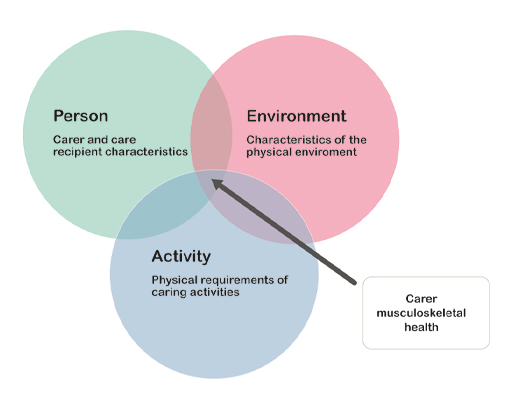4.1 The impact of caring on physical health
Read the quote from Martin, a carer, in Figure 5.
In the quote, Martin highlights the impact the stress of caring had on his immune system, making him vulnerable to contracting illness. Carers also report many other physical health symptoms such as those illustrated in Figure 6.

Figure 6 indicates that musculoskeletal health (e.g. muscle strains, backache) is particularly prevalent amongst carers. It is likely that caring responsibilities such as repositioning, bathing and dressing can increase the potential risk of this type of musculoskeletal injury. Research suggests that there are three key factors that influence the musculoskeletal health of a carer: the person – the characteristics of the carer and the care recipient; the environment and the physical requirements of the caring activities (Darragh et al., 2015; Figure 7).

Research by Darragh et al. (2015), which examined the health of 46 carers of adults with a physical disability, reported that approximately 94% of carers reported musculoskeletal discomfort in at least one body part during the preceding four weeks and 79% perceived that caring either caused or made their symptoms worse. Eighty-two percent of the carers experienced musculoskeletal discomfort in more than one body part in the preceding four weeks, with the lower back being the site of most discomfort, and over half indicated that their symptoms affected work (54.1%), caring (56.4%), and other life activities (66.7%).
Activity 3
If you are a carer, can you relate to any of the symptoms discussed? Can you relate to the injuries and sites of musculoskeletal discomfort? If so, what has been the impact on your caring role, and your life outside of this role?
If you are not a carer, consider how these symptoms could impact on the carers that you were introduced to in Activity 2.
Discussion
If you are a carer you will likely recognise some of the symptoms discussed earlier such as backache and fatigue, either in yourself or carers you know, and will understand the impact these can have. Alternatively, you might have reflected on how these symptoms could impact on the case studies from Activity 2 and how the carers might have been affected. If you have experienced back pain, Carers UK has a useful resource, which is listed in the Further reading section of this course that might be of interest, and it might be that you could seek support on lifting/repositioning etc.
Having considered the physical demands of the caring role, you will now examine the psychological and emotional demands.

